remove seats OPEL CASCADA 2015 Manual user
[x] Cancel search | Manufacturer: OPEL, Model Year: 2015, Model line: CASCADA, Model: OPEL CASCADA 2015Pages: 253, PDF Size: 7.58 MB
Page 44 of 253
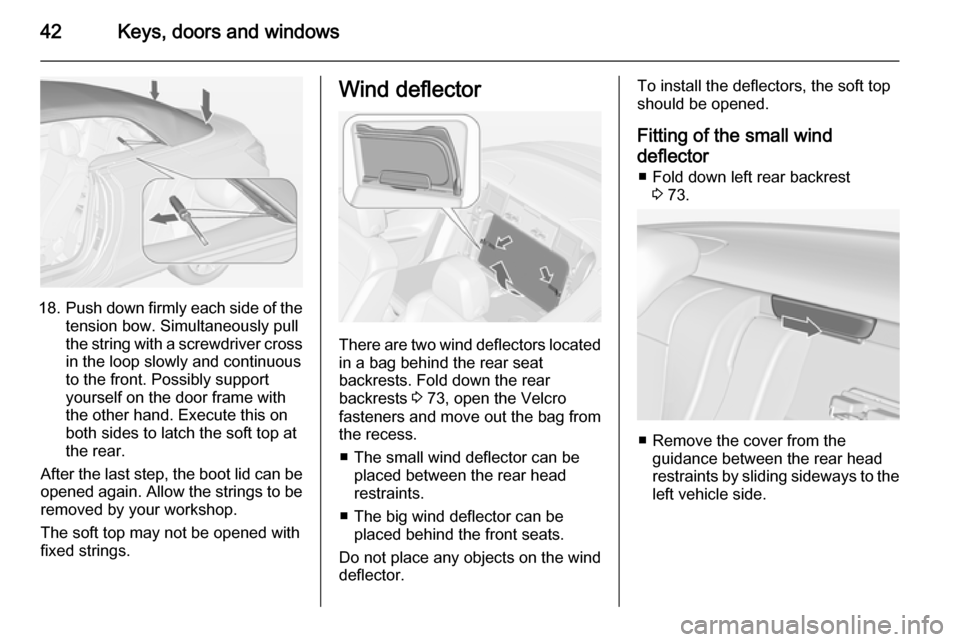
42Keys, doors and windows
18.Push down firmly each side of the
tension bow. Simultaneously pull
the string with a screwdriver cross in the loop slowly and continuous
to the front. Possibly support
yourself on the door frame with
the other hand. Execute this on
both sides to latch the soft top at
the rear.
After the last step, the boot lid can be
opened again. Allow the strings to be removed by your workshop.
The soft top may not be opened with
fixed strings.
Wind deflector
There are two wind deflectors located in a bag behind the rear seat
backrests. Fold down the rear
backrests 3 73, open the Velcro
fasteners and move out the bag from
the recess.
■ The small wind deflector can be placed between the rear head
restraints.
■ The big wind deflector can be placed behind the front seats.
Do not place any objects on the wind
deflector.
To install the deflectors, the soft top
should be opened.
Fitting of the small wind
deflector ■ Fold down left rear backrest 3 73.
■ Remove the cover from the
guidance between the rear head
restraints by sliding sideways to the
left vehicle side.
Page 45 of 253
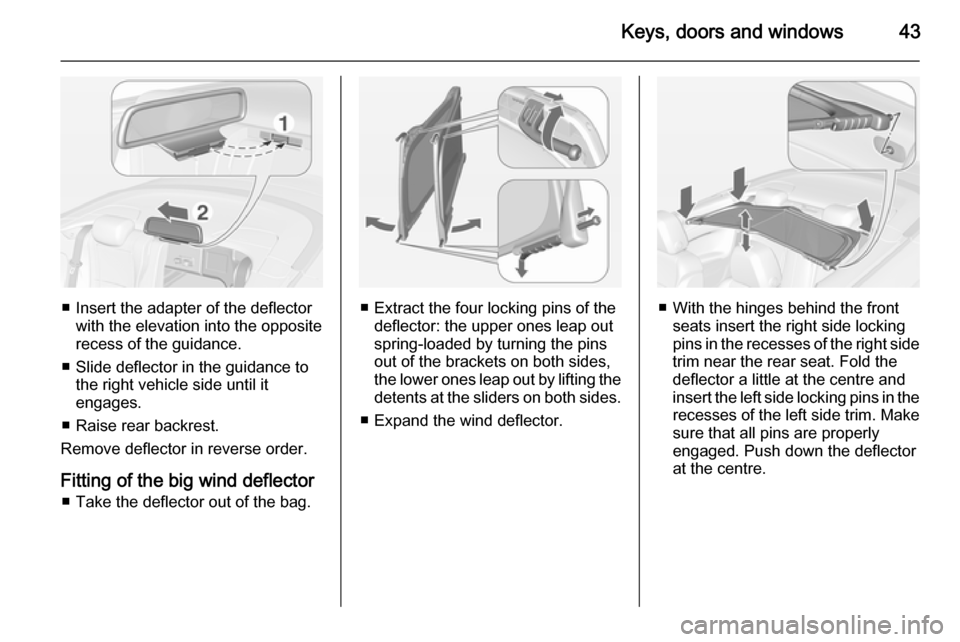
Keys, doors and windows43
■ Insert the adapter of the deflectorwith the elevation into the opposite
recess of the guidance.
■ Slide deflector in the guidance to the right vehicle side until it
engages.
■ Raise rear backrest.
Remove deflector in reverse order.
Fitting of the big wind deflector ■ Take the deflector out of the bag.■ Extract the four locking pins of the deflector: the upper ones leap out
spring-loaded by turning the pins
out of the brackets on both sides,
the lower ones leap out by lifting the
detents at the sliders on both sides.
■ Expand the wind deflector.■ With the hinges behind the front seats insert the right side locking
pins in the recesses of the right side
trim near the rear seat. Fold the
deflector a little at the centre and
insert the left side locking pins in the recesses of the left side trim. Make
sure that all pins are properly
engaged. Push down the deflector
at the centre.
Page 46 of 253
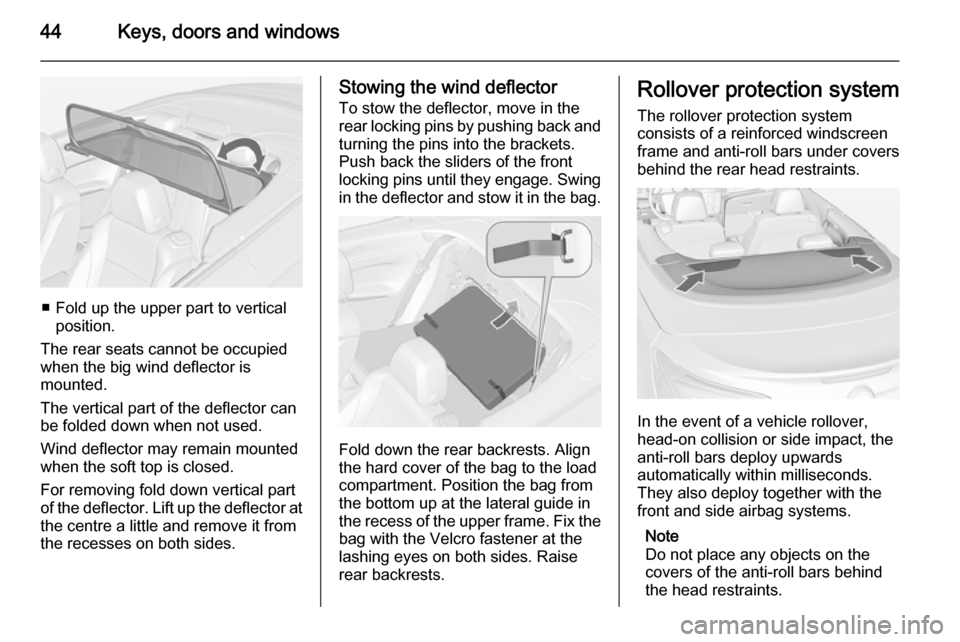
44Keys, doors and windows
■ Fold up the upper part to verticalposition.
The rear seats cannot be occupied
when the big wind deflector is
mounted.
The vertical part of the deflector can
be folded down when not used.
Wind deflector may remain mounted
when the soft top is closed.
For removing fold down vertical part
of the deflector. Lift up the deflector at
the centre a little and remove it from
the recesses on both sides.
Stowing the wind deflector
To stow the deflector, move in the
rear locking pins by pushing back and
turning the pins into the brackets.
Push back the sliders of the front
locking pins until they engage. Swing in the deflector and stow it in the bag.
Fold down the rear backrests. Align
the hard cover of the bag to the load
compartment. Position the bag from
the bottom up at the lateral guide in
the recess of the upper frame. Fix the
bag with the Velcro fastener at the
lashing eyes on both sides. Raise
rear backrests.
Rollover protection system
The rollover protection system
consists of a reinforced windscreen
frame and anti-roll bars under covers
behind the rear head restraints.
In the event of a vehicle rollover,
head-on collision or side impact, the
anti-roll bars deploy upwards
automatically within milliseconds.
They also deploy together with the
front and side airbag systems.
Note
Do not place any objects on the
covers of the anti-roll bars behind
the head restraints.
Page 49 of 253
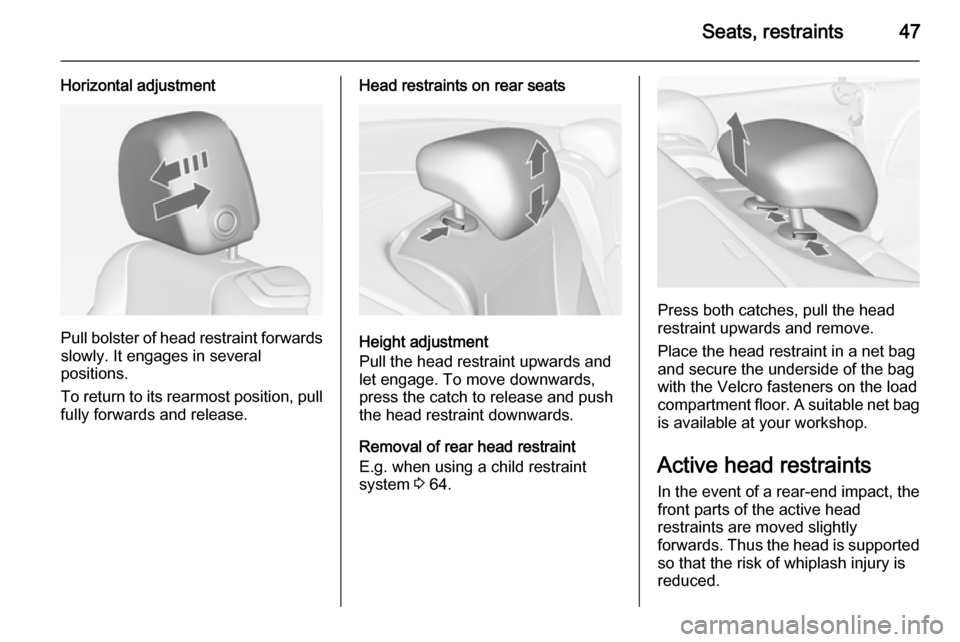
Seats, restraints47
Horizontal adjustment
Pull bolster of head restraint forwardsslowly. It engages in several
positions.
To return to its rearmost position, pull
fully forwards and release.
Head restraints on rear seats
Height adjustment
Pull the head restraint upwards and
let engage. To move downwards, press the catch to release and push
the head restraint downwards.
Removal of rear head restraint
E.g. when using a child restraint
system 3 64.
Press both catches, pull the head
restraint upwards and remove.
Place the head restraint in a net bag
and secure the underside of the bag
with the Velcro fasteners on the load
compartment floor. A suitable net bag
is available at your workshop.
Active head restraints
In the event of a rear-end impact, the front parts of the active head
restraints are moved slightly
forwards. Thus the head is supported
so that the risk of whiplash injury is
reduced.
Page 57 of 253
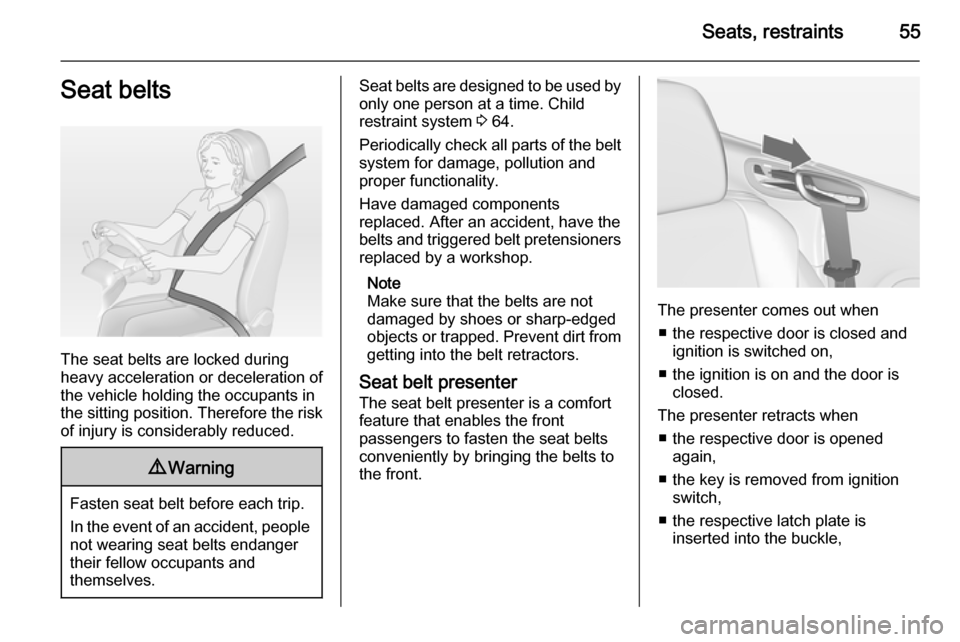
Seats, restraints55Seat belts
The seat belts are locked during
heavy acceleration or deceleration of
the vehicle holding the occupants in
the sitting position. Therefore the risk
of injury is considerably reduced.
9 Warning
Fasten seat belt before each trip.
In the event of an accident, people
not wearing seat belts endanger their fellow occupants and
themselves.
Seat belts are designed to be used by only one person at a time. Child
restraint system 3 64.
Periodically check all parts of the belt
system for damage, pollution and
proper functionality.
Have damaged components
replaced. After an accident, have the
belts and triggered belt pretensioners replaced by a workshop.
Note
Make sure that the belts are not
damaged by shoes or sharp-edged
objects or trapped. Prevent dirt from
getting into the belt retractors.
Seat belt presenter
The seat belt presenter is a comfort
feature that enables the front
passengers to fasten the seat belts
conveniently by bringing the belts to
the front.
The presenter comes out when
■ the respective door is closed and ignition is switched on,
■ the ignition is on and the door is closed.
The presenter retracts when ■ the respective door is opened again,
■ the key is removed from ignition switch,
■ the respective latch plate is inserted into the buckle,
Page 67 of 253
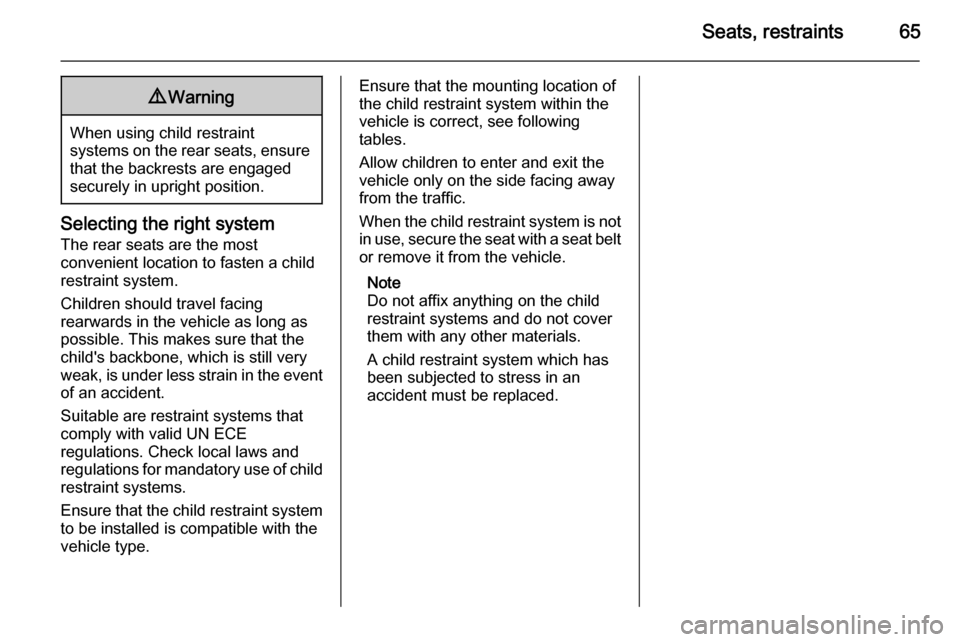
Seats, restraints659Warning
When using child restraint
systems on the rear seats, ensure that the backrests are engaged
securely in upright position.
Selecting the right system
The rear seats are the most
convenient location to fasten a child restraint system.
Children should travel facing
rearwards in the vehicle as long as
possible. This makes sure that the child's backbone, which is still very
weak, is under less strain in the event of an accident.
Suitable are restraint systems that
comply with valid UN ECE
regulations. Check local laws and
regulations for mandatory use of child restraint systems.
Ensure that the child restraint system
to be installed is compatible with the
vehicle type.
Ensure that the mounting location of
the child restraint system within the
vehicle is correct, see following
tables.
Allow children to enter and exit the
vehicle only on the side facing away
from the traffic.
When the child restraint system is not in use, secure the seat with a seat beltor remove it from the vehicle.
Note
Do not affix anything on the child
restraint systems and do not cover
them with any other materials.
A child restraint system which has
been subjected to stress in an
accident must be replaced.
Page 69 of 253

Seats, restraints67
IL=Suitable for particular ISOFIX restraint systems of the 'specific-vehicle', 'restricted' or 'semi-universal' categories. The
ISOFIX restraint system must be approved for the specific vehicle type.IUF=Suitable for ISOFIX forward-facing child restraint systems of universal category approved for use in this weight class.X=No ISOFIX child restraint system approved in this weight class.*=Move the respective front seat ahead of the child restraint system in one of the foremost adjustment positions.**=Remove respective rear head restraint when using child restraint systems in this size class. 3 46.
ISOFIX size class and seat device
A – ISO/F3=Forward-facing child restraint system for children of maximum size in the weight class 9 to 18 kg.B – ISO/F2=Forward-facing child restraint system for smaller children in the weight class 9 to 18 kg.B1 – ISO/F2X=Forward-facing child restraint system for smaller children in the weight class 9 to 18 kg.C – ISO/R3=Rear-facing child restraint system for children of maximum size in the weight class up to 18 kg.D – ISO/R2=Rear-facing child restraint system for smaller children in the weight class up to 18 kg.E – ISO/R1=Rear-facing child restraint system for young children in the weight class up to 13 kg.
Permissible options for fitting a child restraint system
This table relates to all top-tether child restraint systems.
Weight and age classOn front passenger seatOn rear seatsGroup 0: up to 10 kg
or approx. 10 monthsXUGroup 0+: up to 13 kg
or approx. 2 yearsXUGroup I: 9 to 18 kg
or approx. 8 months to 4 yearsXU 1
Page 70 of 253

68Seats, restraints
Weight and age classOn front passenger seatOn rear seatsGroup II: 15 to 25 kg
or approx. 3 to 7 yearsXUGroup III: 22 to 36 kg
or approx. 6 to 12 yearsXU1=Remove rear head restraint when using child restraint systems in this weight group 3 46.U=Universal suitability in conjunction with three-point seat belt.X=No child restraint system permitted in this weight class.
Page 71 of 253
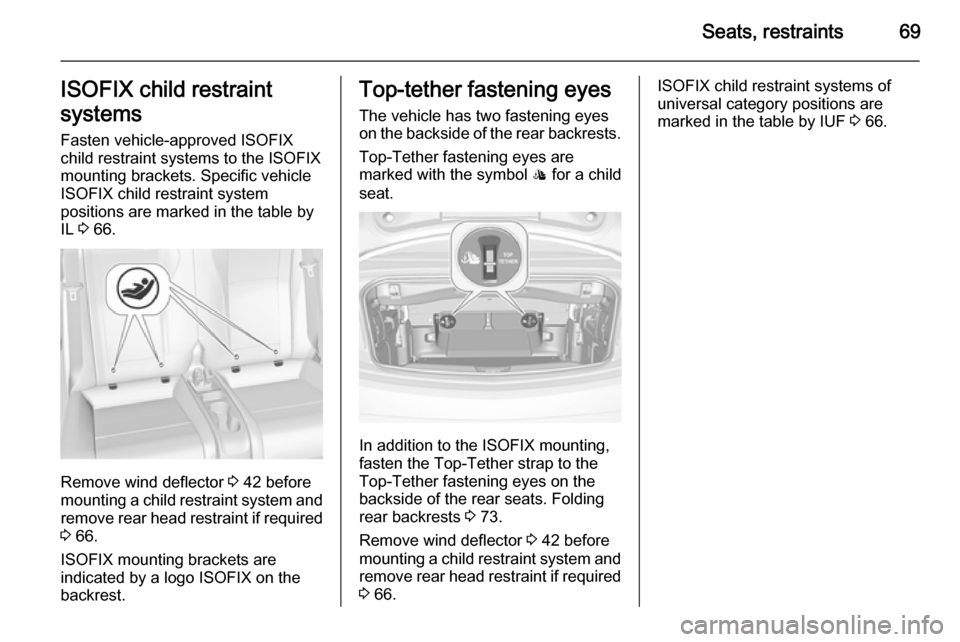
Seats, restraints69ISOFIX child restraint
systems Fasten vehicle-approved ISOFIX
child restraint systems to the ISOFIX
mounting brackets. Specific vehicle
ISOFIX child restraint system
positions are marked in the table by
IL 3 66.
Remove wind deflector 3 42 before
mounting a child restraint system and remove rear head restraint if required
3 66.
ISOFIX mounting brackets are
indicated by a logo ISOFIX on the
backrest.
Top-tether fastening eyes
The vehicle has two fastening eyes
on the backside of the rear backrests.
Top-Tether fastening eyes are
marked with the symbol : for a child
seat.
In addition to the ISOFIX mounting,
fasten the Top-Tether strap to the
Top-Tether fastening eyes on the
backside of the rear seats. Folding
rear backrests 3 73.
Remove wind deflector 3 42 before
mounting a child restraint system and remove rear head restraint if required
3 66.
ISOFIX child restraint systems of
universal category positions are
marked in the table by IUF 3 66.
Page 76 of 253

74Storage9Warning
Take care when operating the
electric foldable rear seats. The seat backrest is folded with
considerable power. Risk of injury, particularly to children.
Ensure that nothing is attached to
the rear seats or located on the
seat cushion.
■ Remove big wind deflector if installed, 3 42.
■ Press the catches and push down the head restraints 3 46.
■ Pull the release switch p on one or
both sides of the load
compartment, to fold down the
backrests onto the seat cushion.
■ To fold up, raise the backrest and guide it into an upright position until
it engages audibly.9 Warning
When folding up, ensure that
backrests are securely locked in
position before driving. Failure to
do so may result in personal injury or damage to the load or vehicle in the event of hard braking or a
collision.
Pass-through flap behind rear seats
For transporting long objects in the
load compartment, a pass-through
flap between load compartment and
vehicle interior can be opened:
■ Remove the installed big wind deflector or the bag with the stowed
wind deflectors behind the rear seats 3 42.
■ Close soft top 3 35.
■ Push the load compartment partition at the loop area upwards
to the inside 3 73.